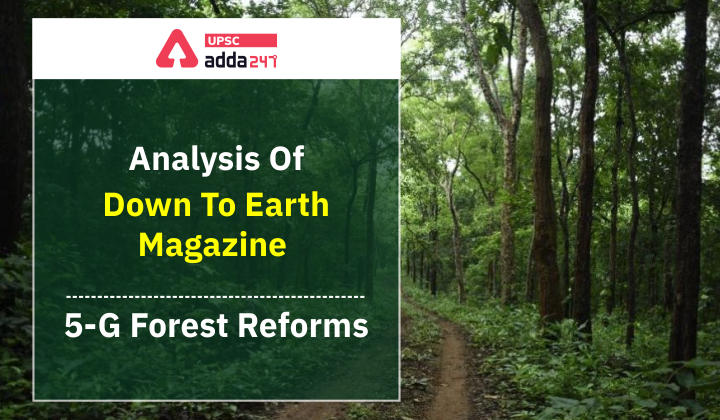Table of Contents
Analysis Of Down To Earth Magazine: 5-G Forest Reforms
Relevance
”GS 1 & GS 3: Physical Geography, Forest Resources, Environment”
Introduction
- The recently released India State of Forest Report (ISFR) 2021 shows the total forest and tree cover in India is 80.9 million hectares, which is 24.62 per cent of the geographical area of the country.
- According to ISFR 2021, India’s forest cover has increased between the last assessment in 2019 and the latest in 2021 by a minuscule 0.16 million ha—a rise of a mere 0.2 per cent.
- The increase in forest cover has happened outside recorded forest area, or forest land under the control of state government’s forest department.
- The biggest takeaway is, therefore, that forests with forest departments are not growing; and one-third of their land is not even fit for assessment. Forest cover is growing in spite of the government, not because of it.
- So we need fifth-generation forest reforms (5-G forest reform), which will secure forests for growth and livelihood.
History of Forest Management in the country
Forest management started in India with the colonial British government, which took away community lands and nationalised them.
- Phase 1: The forests were meant for extraction to aid the colonial government’s economic exploitation of the country’s resources.
- Phase 2: Started in the 1980s, when the Forest Conservation Act and its subsequent amendments were passed, centralising the “diversion” of forest land. The push for this was the growing awareness of the rate of deforestation in mid 1980s.
- Phase 3: Came with the mission for afforestation—first it was about growing trees outside forests, in the wastelands that were thought to exist across the country.
- Phase 4: Continues till today where forests are a permanent battleground. The Scheduled Tribes and Other Traditional Forest Dwellers (Recognition of Forest Rights) Act (fra), 2006, has corrected a historical injustice, giving communities rights over the land they have been living on.
What is Carbon Stock
- It calculates the amount of carbon stored in biomass—in woody growing stock, in vegetation, in leaf litter and soil.
- According to ISFR 2021, initially, the Forest Survey of India (FSI) had only calculated the woody growing stock and extrapolated the vegetation to estimate forest carbon.
- According to ISFR 2021, there is a net increase of 79.4 million tonnes in carbon stock between 2019 and 2021.
- The bulk of the carbon stock—56 per cent—is in the soil as per this assessment.
- Trees Outside Forest (TOF) is 8.94 per cent of the country’s geographical area and nearly 38 per cent of the carbon stock.
What should be the 5-G Forest Reforms?
- The 5-G forest reforms should be based on the learning from the past—we must shed reticence to plant what will be cut.
- The fact is that while the first phase of forest management in the country was extractive and exploitative, this 4th phase continues to be based on conservation to the extent that felling trees planted on one’s own land has become a crime.
What should be the Future agenda for forests?
- Protection of the remaining very dense and ecologically significant forests is critical.
- Plan to cut and plant again on forest land with communities.
- End the license-raj on trees outside forests.
Conclusion
This in times when, on the one hand, there is a need for enhanced protection of the remaining forests for ecological security, and on the other, there is a crucial need to build the resilience of communities who live in these habitats—all in the times of increased risk because of climate change.



 TSPSC Group 1 Question Paper 2024, Downl...
TSPSC Group 1 Question Paper 2024, Downl...
 TSPSC Group 1 Answer key 2024 Out, Downl...
TSPSC Group 1 Answer key 2024 Out, Downl...
 UPSC Prelims 2024 Question Paper, Downlo...
UPSC Prelims 2024 Question Paper, Downlo...




